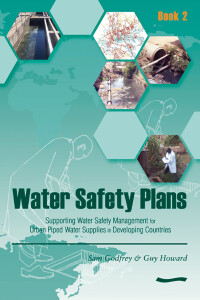-
Appropriate chlorination techniques for wells in Angola
01.04.2003
Traditional wells in Internally Displaced People's camps are often contaminated. This eight-stage method describes how to select wells for chlorination, assess the correct dosage of chlorine and involve community members in water testing and hygiene education. -
Is your drinking water safe?
01.04.2005
Does the monitoring of water quality ensure safe water? Or is the real risk poor understanding of the operation of water-supply systems? The new water-safety framework should help utilities and communities identify where contamination is arising, and show how to put problems right. -
Implementing water-safety plans in urban piped-water supplies in Uganda
01.04.2005
When water-safety plans were implemented in Kampala and Jinja, Uganda, they were found to be a cost-effective way of identifying supply problems and a good way of involving operations as well as water-quality staff, thereby reducing response times. -
Resourses Guide
01.04.2005
-
Water-safety plans for piped supplies with limited data – a case study from India
01.04.2005
Problems arise implementing WSPs in many towns where data on the piped network is limited. Risk mapping can be a useful tool to overcome this and identify points where risk is particularly high. It uses local engineers' knowledge to assess physical hazards and the vulnerability of the pipework and uses proxies for the susceptibility of the population to disease. -
Rainwater as an additional water supply
01.04.2006
-
Water safety plans for greywater in tribal schools, India
01.01.2007
Where water is in short supply, greywater treatment and reuse may be the answer. Such systems have been introduced in tribal residential schools in Madhya Pradesh, India. Both children and parent teacher associations were involved in drawing up and applying water safety plans for greywater reuse, and cartoons were used to publicize them. -
Books
01.07.2007


